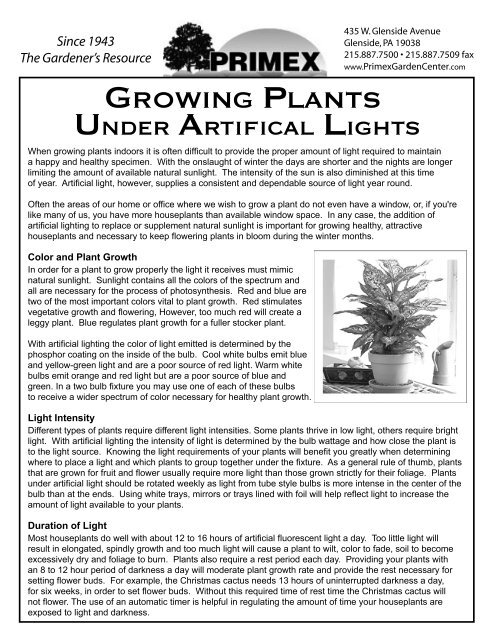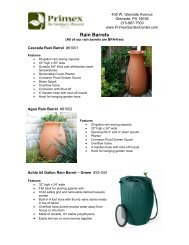GROWING PLANTS Under Artifical Lights - Primex Garden Center
GROWING PLANTS Under Artifical Lights - Primex Garden Center
GROWING PLANTS Under Artifical Lights - Primex Garden Center
Create successful ePaper yourself
Turn your PDF publications into a flip-book with our unique Google optimized e-Paper software.
Since 1943<br />
The <strong>Garden</strong>er’s Resource<br />
<strong>GROWING</strong> <strong>PLANTS</strong><br />
<strong>Under</strong> <strong>Artifical</strong> <strong>Lights</strong><br />
When growing plants indoors it is often difficult to provide the proper amount of light required to maintain<br />
a happy and healthy specimen. With the onslaught of winter the days are shorter and the nights are longer<br />
limiting the amount of available natural sunlight. The intensity of the sun is also diminished at this time<br />
of year. Artificial light, however, supplies a consistent and dependable source of light year round.<br />
Often the areas of our home or office where we wish to grow a plant do not even have a window, or, if you're<br />
like many of us, you have more houseplants than available window space. In any case, the addition of<br />
artificial lighting to replace or supplement natural sunlight is important for growing healthy, attractive<br />
houseplants and necessary to keep flowering plants in bloom during the winter months.<br />
Color and Plant Growth<br />
In order for a plant to grow properly the light it receives must mimic<br />
natural sunlight. Sunlight contains all the colors of the spectrum and<br />
all are necessary for the process of photosynthesis. Red and blue are<br />
two of the most important colors vital to plant growth. Red stimulates<br />
vegetative growth and flowering, However, too much red will create a<br />
leggy plant. Blue regulates plant growth for a fuller stocker plant.<br />
With artificial lighting the color of light emitted is determined by the<br />
phosphor coating on the inside of the bulb. Cool white bulbs emit blue<br />
and yellow-green light and are a poor source of red light. Warm white<br />
bulbs emit orange and red light but are a poor source of blue and<br />
green. In a two bulb fixture you may use one of each of these bulbs<br />
to receive a wider spectrum of color necessary for healthy plant growth.<br />
435 W. Glenside Avenue<br />
Glenside, PA 19038<br />
215.887.7500 • 215.887.7509 fax<br />
www.<strong>Primex</strong><strong>Garden</strong><strong>Center</strong>.com<br />
Light Intensity<br />
Different types of plants require different light intensities. Some plants thrive in low light, others require bright<br />
light. With artificial lighting the intensity of light is determined by the bulb wattage and how close the plant is<br />
to the light source. Knowing the light requirements of your plants will benefit you greatly when determining<br />
where to place a light and which plants to group together under the fixture. As a general rule of thumb, plants<br />
that are grown for fruit and flower usually require more light than those grown strictly for their foliage. Plants<br />
under artificial light should be rotated weekly as light from tube style bulbs is more intense in the center of the<br />
bulb than at the ends. Using white trays, mirrors or trays lined with foil will help reflect light to increase the<br />
amount of light available to your plants.<br />
Duration of Light<br />
Most houseplants do well with about 12 to 16 hours of artificial fluorescent light a day. Too little light will<br />
result in elongated, spindly growth and too much light will cause a plant to wilt, color to fade, soil to become<br />
excessively dry and foliage to burn. Plants also require a rest period each day. Providing your plants with<br />
an 8 to 12 hour period of darkness a day will moderate plant growth rate and provide the rest necessary for<br />
setting flower buds. For example, the Christmas cactus needs 13 hours of uninterrupted darkness a day,<br />
for six weeks, in order to set flower buds. Without this required time of rest time the Christmas cactus will<br />
not flower. The use of an automatic timer is helpful in regulating the amount of time your houseplants are<br />
exposed to light and darkness.
Since 1943<br />
The <strong>Garden</strong>er’s Resource<br />
435 W. Glenside Avenue<br />
Glenside, PA 19038<br />
215.887.7500 • 215.887.7509 fax<br />
www.<strong>Primex</strong><strong>Garden</strong><strong>Center</strong>.com<br />
Incandescent vs. Fluorescent<br />
<strong>Under</strong>standing the difference between incandescent and fluorescent light will help you choose the best<br />
artificial lighting for your houseplants.<br />
Most of the bulbs used in our home and place of business are incandescent. These bulbs are economically<br />
priced. The major drawback is that incandescent bulbs are inefficient; they require more energy to produce<br />
light than fluorescent and therefore are more expensive to use. Incandescent bulbs produce mostly red light<br />
and do not produce sufficient blue rays to meet plant needs. Incandescent bulbs also burn hot and create a<br />
dry environment, reducing humidity and potentially scorching plant leaves.<br />
Fluorescent bulbs on the other hand are more expensive to purchase but are less expensive to use. They<br />
produce more light with less energy. A fluorescent bulb produces 2 ½ to 3 times more light than an<br />
incandescent bulb of the same wattage. Whereas incandescent bulbs produce mostly red light, regular<br />
fluorescent bulbs produce mostly blue rays with an insufficient amount red needed for plant health.<br />
Fluorescent bulbs burn cool so they do not dry the air or scorch plant leaves.<br />
One option for providing adequate light for growing houseplants is to use a two bulb fixture with one<br />
incandescent and one fluorescent bulb, this will supply the full spectrum of light required to grow both<br />
flowering and foliage plants. A better alternative is to use what is called a ?full-spectrum fluorescent<br />
gro-bulb . These artificial lights have all the benefits of fluorescent bulbs with the added advantage of<br />
providing the full range of colors required for plant growth all in one bulb. Full-spectrum fluorescent<br />
gro-bulbs are the best lighting choice for houseplant care.<br />
Fixtures<br />
When choosing a plant light fixture, the most important feature is that the fixture be adjustable. You should<br />
be able to adjust the fixture up and down to account for the growth height and varied light intensity<br />
requirements of a variety of plants. If the fixture is not adjustable you will limit the type of plants that you<br />
can grow. Simple shop lights and table-top light fixtures are both adjustable and good choices for lighting<br />
houseplants. Another consideration is the size of the fixture. Size choice is based on the number of plants<br />
that you plan to grow under the light. Lighted plant carts provide multi levels of lighted shelves on which to<br />
grow plants. Carts are on wheels which make them easy to relocate, table-top fixtures are light-weight and<br />
easily transported to other locations when necessary.<br />
At <strong>Primex</strong> we carry everything required for healthy houseplants. Stop by our store so that we can introduce<br />
you to our selection of artificial lighting items. Our excellent greenhouse staff can provide you with information<br />
regarding the care of your houseplants or check out our Greenhouse Care Sheet from your computer at home.








